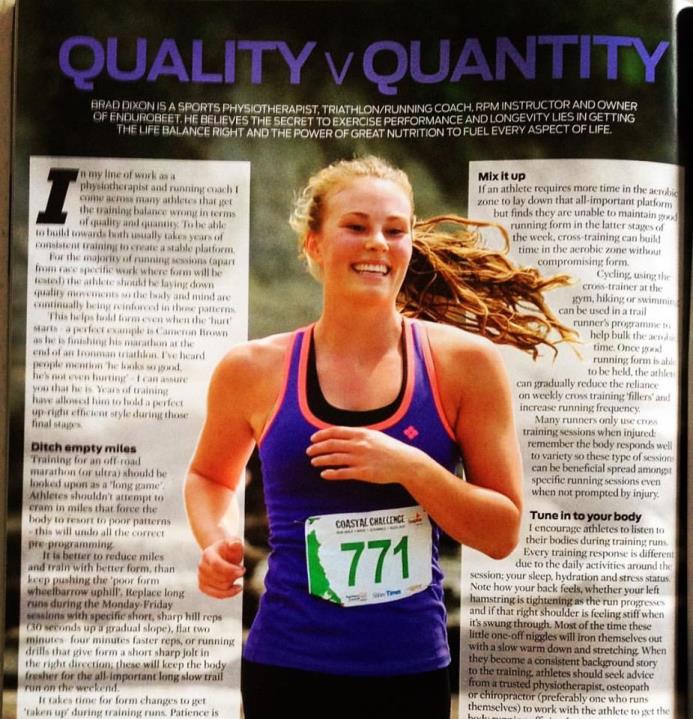Quality v Quantity
Injury prevention, February 19, 2016
This article was published in the KIWI trail runner (issue 4) and unpacks the quality v quantity debate. 80% of all running injuries are due to training error. Build with quality in mind and listen to your body.
In my line of work as a physiotherapist and running coach I come across so many athletes that get the training balance wrong in terms of quality and quantity. To be able to build towards both usually takes years of consistent training to create a stable platform.
For the majority of running sessions (apart from some race specific work where form will be tested) the athlete should be laying down quality movements so that the body and mind is continually getting reinforced on those patterns. This helps hold form even when the "hurt" starts. A perfect example is Cameron Brown as he is finishing his marathon at the end of an Ironman triathlon. I've heard people mention "he looks so good, he's not even hurting". I can assure you he is. Years of training have allowed him to be able to hold his perfect up-right efficient style during those final stages.
Training for ultra-trail running should be looked upon as a “long game”. Athletes shouldn’t attempt to cram in miles that then force the body to resort to poor patterns. This will undo all the correct pre-programming. Athletes are always better to reduce miles and train with better form than keep pushing the "poor form wheelbarrow up hill". Rather than running longer miles during the Monday-Friday sessions look at specific short sharp hill reps (30 sec up a gradual slope), flat 2-4min faster reps, or running drills that give running form a short sharp jolt in the right direction; this will keep the body fresher for the all-important long slow trail run on the weekend. It takes time for form changes to get “taken up” during training runs. Patience is required and don’t expect to be able to run the entire long run with the improved form that was managed for shorter faster sessions when you are fresh. The overlay will take time. My advice is to really concentrate for short periods during the longer run and notice how it feels, then graduate as able.
Another great use of time is going out for a 30-40min session (depending on time available) incorporating functional body weight exercises (for example push ups, burpees, walking lunge, box jumps - on to a park bench seat, and planks) with running used as a warm-up and warm-down sandwiched either side. This session could be more beneficial compared to the 90min STEADY run mid-week.
If the athlete requires more time in the aerobic zone to lay down that all important platform but is unable to maintain form in the 4th and 5 th running session in the weeks programme then use other cross-training sessions to build time up without compromising form. Cycling, using the cross-trainer at the gym, hiking, or swimming should be used in a trail runners programme to help bulk the aerobic time. Once the form is able to be held then the athlete can gradually reduce the reliance on weekly cross training “fillers” and increase the frequency of the running. Many will only use cross training sessions when injured – remember the body responds well to variety so these type of sessions can be very beneficial spread amongst the more specific running sessions even when the athlete is not needing them as a “filler”.
I also encourage athletes to listen to their bodies during the training runs. Every training response is different due to the daily activities around the session, your sleep, hydration, and stress status. Note how your back feels, whether your left hamstring is tightening as the run progresses, and if that right shoulder is feeling stiff when it’s swung through. Most of the time these little one off niggles, that don't affect form; will iron themselves out with the general slow warm down and stretching. When these become a consistent background story to the training athletes should seek advice from a trusted physiotherapist, osteopath, or chiropractor (preferably one who runs themselves) to work with the athlete to get the body running efficiently again. Using body awareness techniques will stop a serious injury developing allowing more consistency in training (this is the not so secret secret to endurance training success).
My overall feeling is that trail runners would benefit from running a 40-60km week with specific sessions allowing great technique rather than running 100k weeks with no focus other than logging miles with form slowly deteriorating. This is especially true for runners early in their running careers. Running long with poor form only lays the groundwork for niggly overuse injuries (that inexperienced athletes always attempt to train through). Going down this path leads to injury inducing training and disappointing race day stories.

.jpg?version=8)